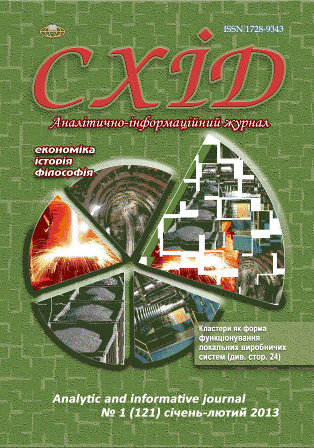Rating approach to complex evaluation of investment attractiveness of coal mining enterprises
DOI:
https://doi.org/10.21847/1728-9343.2013.1(121).23307Keywords:
rating, investment attractiveness, assessment, coal mining enterprisesAbstract
The research work has resulted in determination and specification of the content and constitutive elements of an investment process, the basic approaches in determination of investment attractiveness as well as methods of its evaluation. The application of artificial neural networks, elements of fuzzy logic and clastering within Neuro-Fuzzy Interence System using Kohonen's self organizing feature maps and the bell-shaped presence function have been grounded. In the article the relevance of using the rating approach for evaluation of investment attractiveness has been grounded. The structure of incoming dataset to be used for the rating evaluation has been suggested. The set of parameters to characterize the rating scale has been calculated. The rating index of complex evaluation of investment attractiveness "piar" has been formed. The generalizing rating scale used for complex evaluation of investment attractiveness of coal-mining enterprises has been designed, and the generalizing rating of investment attractiveness of the enterprises under consideration has been formed.
Downloads
References
Концепція розвитку вугільної промисловості України. Розпорядження Кабінету Міністрів України від 07.07.2005 № 236-р // Офіційний вісник України.- 22.07.2005.- № 27.
Енергетична стратегія України на період до 2030 року. Розпорядження Кабінету Міністрів України від 15 березня 2006 р. N 145-р .
Програми економічних реформ на 2010-2014 роки "Заможне суспільство, конкурентоспроможна економіка, ефективна держава". Розпорядження Кабінету Міністрів України вiд 23.06.2010 № 1724-р // Урядовий кур'єр. - 02.09.2010. - №161.
Великоіваненко Г. І. Комплекс економіко-математичних моделей оцінювання інвестиційної привабливості суб'єктів господарювання / Г. І. Великоіваненко, К. М. Мамонова // Нейро-нечіткі технології моделювання в економіці. -2012. - № 1. - С. 65-96.
Рутковская Д. Нейронные сети, генетические алгоритмы и нечеткие системы / Д. Рутковская, М. Пилиньский, Л. Рутковский; пер. с польского И. Д. Рудинского. - М.:Горячая линия - Телеком, 2004. - 452 с.
Захаров В.А. О выборе методов построения функций принадлежности для формализации задач принятия решений [Електроний ресурс] / В.А. Захаров. - Режим доступу: http://sgma.alpha-design.ru/MMORPH/N-12-html/borisov/zakharov/zakharov.htm.
Леоненков А.В. Нечеткое моделирование в среде Matlab и fuzzyTECH / А.В. Леоненков. - С-Пб.: BHV-Санкт-Петербург, 2003. - 736 с.
Government of Ukraine (2005), The concept of the coal industry of Ukraine. (Order of Government of Ukraine) Kiev: Official Bulletin of Ukraine.
Government of Ukraine (2006), Energy Strategy of Ukraine till 2030. (Order of Government of Ukraine) Kiev: Official Bulletin of Ukraine.
Government of Ukraine (2010), Economic Reform Program for 2010-2014 "Prosperous Society, Competitive Economy, Effective State"/ (Order of Government of Ukraine) Kiev: Official Bulletin of Ukraine.
Velykoivanenko G. I., Mamonova K.M. (2012), Kompleks ekonomiko-matematychnyh modelej ocinyuvannya investycijnoyi pryvablyvosti subyektiv gospodaryuvannya, Nejro-nechitki texnologiyi modelyuvannya v ekonomici, 1 (1), pp. 65-96.
Rutkovskaya D., Pylynskyj M., Rutkovskyj L. (2004), Nejronnye seti, geneticheskie algoritmy i nechetkie sistemy. Moskow, Gorjachaja linija - Telekom, 452 p.
Zaharov V.A., (2012), O vybore metodov postroenija funkcij prinadlezhnosti dlja formalizacii zadach prinjatija reshenij, available at: http://sgma.alpha-design.ru/MMORPH/N-12-html/borisov/zakharov/zakharov.htm. Last accessed 2012.
Leonenkov A.V. (2003), Nechetkoe modelirovanie v srede Matlab i fuzzyTECH, St. Petersburg, BHV-Sankt-Peterburg, 736 p.
Downloads
Published
How to Cite
Issue
Section
License
Copyright (c) 2014 Ihor Hryshko

This work is licensed under a Creative Commons Attribution-NonCommercial-NoDerivatives 4.0 International License.
1. Authors bear responsibility for the accuracy of facts, quotations, numbers and names used.
2. Manuscripts are not sent back.
3. The publisher does not always agree with the authors' opinion.
4. The authors reserve the right to authorship of the work and pass the first publication right of this work to the journal under the terms of a Creative Commons Attribution-NonCommercial-NoDerivatives 4.0 International License. This license allows others to distribute (copy) the published work for non-commercial purposes, provided there is mandatory attribution to its authors and a link to the first publication in our journal.
5. The authors have the right to conclude separate supplement agreements that relate to non-exclusive work distribution in the form in which it has been published by the journal (for example, to upload the work to the online storage of the journal or publish it as part of a monograph), provided that the reference to the first publication of the work in this journal is included.

